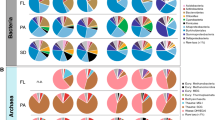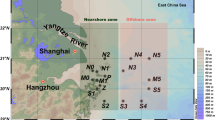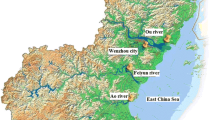Abstract
We analyzed, by terminal restriction fragment length polymorphisms (T-RFLPs) of PCR-amplified 16S rDNA, microbial diversity in water collected during the dry and wet seasons in a human-impacted coastal lagoon. Water samples were fractionated by prefiltration to differentiate particle-associated and free-living microbes. From a sample collected during the dry season, prefiltration removed 23 to 44% of bacteria, as assessed by direct counts and MPN, and 99% of phytoplankton, as assessed by chlorophyll a. Restriction with RsaI yielded fewer peaks than restriction with HhaI. Diversity indices calculated from T-RFLPs were higher in the lagoon than adjoining coastal waters and higher in the particle-associated than the free-living fraction. In the dry season, peaks found only in bulk and particle-associated T-RFLPs were consistent with plastid and cyanobacterial ribotypes. These peaks matched those observed in the sequence of a clone generated from the bulk fraction with plastid and cyanobacterial specific primers. This clone appeared related to plastids found in the diatom genus Skeletonema. Principal component analysis of T-RFLPs suggested that the difference between the free-living and particle-associated fractions in the dry season was less than temporal variability in this lagoon and that these fractions varied significantly only in the wet season. This fractionation of microbial populations into particle-associated and free-living guilds during the wet season, when water residence time in the lagoon is relatively low, suggests an external source of particle-associated bacteria such as erosion of upland soils by runoff.
Similar content being viewed by others
References
Acinas SG, Antón J, Rodríguez-Valera F (1999) Diversity of free-living and attached bacteria in offshore western Mediterranean waters as depicted by analysis of genes encoding 16S rRNA. Appl Environ Microbiol 65:514–522
Artolozaga I, Valcarcel M, Ayo B, Latatu A, Iriberri J (2002) Grazing rates of bacterivorous protists inhabiting diverse marine planktonic microenvironments. Limnol Oceanogr 47:142–150
Atlas RM, Bartha R (1993) Microbial Ecology: Fundamentals and Applications, 3rd ed. Benjamin/Cummings, Redwood City, CA
Ayo B, Unanue M, Azua I, Gorsky G, Turley C, Iriberri J (2001) Kinetics of glucose and amino acid uptake by attached and free-living marine bacteria in oligotrophic waters. Mar Biol 138:1071–1076
Bartscht K, Cypionka H, Overmann J (1999) Evaluation of cell activity and of methods for the cultivation of bacteria from a natural lake community. FEMS Microbiol Ecol 28:249–259
Benlloch S, Rodríguez-Valera F, Martinez-Murcia AJ (1995) Bacterial diversity in two coastal lagoons deduced from 16S rDNA PCR amplification and partial sequencing. FEMS Microbiol Ecol 18:267–280
Bidle KD, Fletcher M (1995) Comparison of free-living and particle-associated bacterial communities in the Chesapeake Bay by stable low-molecular-weight RNA analysis. Appl Environ Microbiol 61:944–952
Buckling A, Kassen R, Bell G, Rainey PB (2000) Disturbance and diversity in experimental microcosms. Nature 408:961–964
Chandler DP (1998) Redefining relativity: quantitative PCR at low template concentrations for industrial and environmental microbiology. J Ind Microbiol Biotechnol 21:128–140
Clement BG, Kitts CL (2000) Isolating PCR-quality DNA from human feces with a soil DNA kit. Biotechniques 28:640–646
Crump BC, Armbrust EV, Baross JA (1999) Phylogenetic analysis of particle-attached and free-living bacterial communities in the Columbia River, its estuary, and the adjacent coastal ocean. Appl Environ Microbiol 65:3192–3204
Crump BC, Baross JA, Simenstad CA (1998) Dominance of particle-attached bacteria in the Columbia River estuary, USA. Aquat Microb Ecol 14:7–18
Delong EF, Franks DG, Alldredge AL (1993) Phylogenetic diversity of aggregate-attached vs free-living marine bacterial assemblages. Limnol Oceanogr 38:924–934
Dunbar J, Ticknor LO, Kuske CR (2001) Phylogenetic specificity and reproducibility and new method for analysis of terminal restriction fragment profiles of 16S rRNA genes from bacterial communities. Appl Environ Microbiol 67:190–197
Fisher MM, Wilcox LW, Graham LE (1998) Molecular characterization of epiphytic bacterial communities on charophycean green algae. Appl Environ Microbiol 64:4384–4389
Fogel GB, Collins CR, Li J, Brunk CF (1999) Prokaryotic genome size and SSU rDNA copy number: estimation of microbial relative abundance from a mixed population. Microb Ecol 38:93–113
Frostegärd Å, Courtois S, Ramisse V, Clerc S, Bernillon D, Le Gall F, Jeannin P, Nesme X, Simonet P (1999) Quantification of bias related to the extraction of DNA directly from soils. Appl Environ Microbiol 65:5409–5420
Fukuda R, Ogawa H, Nagata T, Koike I (1998) Direct determination of carbon and nitrogen contents of natural bacterial assemblages in marine environments. Appl Environ Microbiol 64:3352–3358
Giovannoni SJ, Delong EF, Schmidt TM, Pace NR (1990) Tangential flow filtration and preliminary phylogenetic analysis of marine picoplankton. Appl Environ Microbiol 56:2572–2575
Glöckner FO, Fuchs BM, Amann R (1999) Bacterioplankton compositions of lakes and oceans: a first comparison based on fluorescence in situ hybridization. Appl Environ Microbiol 65:3721–3726
Hollibaugh JT, Wong PS, Murrell MC (2000) Similarity of particle-associated and free-living bacterial communities in northern San Francisco Bay, California. Aquat Microb Ecol 21:103–114
Knap AH, Michaels AF, Dow RL, Johnson RJ, Gundersen K, Sorensen JC, Close AR, Howse FA, Hammer M, Bates N, Doyle A, Waterhouse T (1993) BATS Method Manual Version 3. U.S. Joint Global Ocean Flux Study Planning and Coordination Office, Woods Hole, MA
Krsek M, Wellington EMH (1999) Comparison of different methods for the isolation and purification of total community DNA from soil. J Microbiol Methods 39:1–16
LaMontagne MG, Michel FC, Holden PA, Reddy CA (2002) Evaluation of extraction and purification methods for obtaining PCR-amplifiable DNA from compost for microbial community analysis. J Microbiol Methods 49:255–264
Langenheder S, Jurgens K (2001) Regulation of bacterial biomass and community structure by metazoan and protozoan predation. Limnol Oceanogr 46:121–134
Liu WT, Marsh TL, Cheng H, Forney LJ (1997) Characterization of microbial diversity by determining terminal restriction fragment length polymorphisms of genes encoding 16S rRNA. Appl Environ Microbiol 63:4516–4522
Logan BE, Hilbert TA, Arnold RG (1993) Removal of bacteria in laboratory filters: models and experiments. Wat Res 27:955–962
Long RA, Azam F (2001) Antagonistic interactions among marine pelagic bacteria. Appl Environ Microbiol 67:4975–4983
Maidak BL, Cole JR, Lilburn TG, Parker CT, Saxman PR, Farris RJ, Garrity GM, Li B, Olsen GJ, Pramanik S, Schmidt TM, Tiedje JM (2001) The RDP-II (Ribosomal Database Project). Nucleic Acids Res 29:173–174
Moeseneder MM, Arrieta JM, Muyzer G, Winter C, Herndl GJ (1999) Optimization of terminal-restriction fragment length polymorphism analysis for complex marine bacterioplankton communities and comparison with denaturing gradient gel electrophoresis. Appl Environ Microbiol 65:3518–3525
Moeseneder MM, Winter C, Herndl GJ (2001) Horizontal and vertical complexity of attached and free-living bacteria of the eastern Mediterranean Sea, determined by 16S rDNA and 16S rRNA fingerprints. Limnol Oceanogr 46:95–107
Noble PA, Bidle KD, Fletcher M (1997) Natural microbial community compositions compared by a back-propagating neural network and cluster analysis of 5S rRNA. Appl Environ Microbiol 63:1762–1770
Noble RT, Fuhrman JA (1998) Use of SYBR Green I for rapid epifluorescence counts of marine viruses and bacteria. Aquat Microb Ecol 14:113–118
Nubel U, Garcia-Pichel F, Muyzer G (1997) PCR primers to amplify 16S rRNA genes from cyanobacteria. Appl Environ Microbiol 63:3327–3332
Osborn AM, Moore ERB, Timmis KN (2000) An evaluation of terminal-restriction fragment length polymorphism (T-RFLP) analysis for the study of microbial community structure and dynamics. Environ Microbiol 2:39–50
Polz MF, Cavanaugh CM (1998) Bias in template-to-product ratios in multitemplate PCR. Appl Environ Microbiol 64:3724–3730
Porteous LA, Seidler RJ, Watrud LS (1997) An improved method for purifying DNA from soil for polymerase chain reaction amplification and molecular ecology applications. Mol Ecol 6:787–791
Revilla M, Iriarte A, Madariaga I, Orive E (2000) Bacterial and phytoplankton dynamics along a trophic gradient in a shallow temperate estuary. Estuar Coast Shelf Sci 50:297–313
Riemann L, Winding A (2001) Community dynamics of free-living and particle-associated bacterial assemblages during a freshwater phytoplankton bloom. Microb Ecol 42:274–285
Somerville CC, Knight IT, Straube WL, Colwell RR (1989) Simple, rapid method for direct isolation of nucleic acids from aquatic environments. Appl Environ Microbiol 55:548–554
Suzuki MT, Giovannoni SJ (1996) Bias caused by template annealing in the amplification of mixtures of 16S rRNA genes by PCR. Appl Environ Microbiol 62:625–630
Tebbe CC, Vahjen W (1993) Interference of humic acids and DNA extracted directly from soil in detection and transformation of recombinant DNA from bacteria and a yeast. Appl Environ Microbiol 59:2657–2665
Urbach E, Vergin KL, Young L, Morse A, Larson GL, Giovannoni SJ (2001) Unusual bacterioplankton community structure in ultra-oligotrophic Crater Lake. Limnol Oceanogr 46:557–572
Worm J, Gustavson K, Garde K, Borch NH, Sondergaard M (2001) Functional similarity of attached and free-living bacteria during freshwater phytoplankton blooms. Aquat Microb Ecol 25:103–111
Yuan W, Zydney AL (1999) Humic acid fouling during microfiltration. J Membr Sci 157:1–12
Zhou JZ, Davey ME, Figueras JB, Rivkina E, Gilichinsky D, Tiedje JM (1997) Phylogenetic diversity of a bacterial community determined from Siberian tundra soil DNA. Microbiology (UK) 143:3913–3919
Author information
Authors and Affiliations
Corresponding author
Additional information
Online publication: 6 June 2003
Rights and permissions
About this article
Cite this article
LaMontagne, M.G., Holden, P.A. Comparison of free-living and particle-associated bacterial communities in a coastal Lagoon. Microb Ecol 46, 228–237 (2003). https://doi.org/10.1007/s00248-001-1072-y
Received:
Accepted:
Issue Date:
DOI: https://doi.org/10.1007/s00248-001-1072-y




